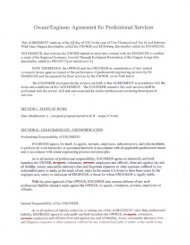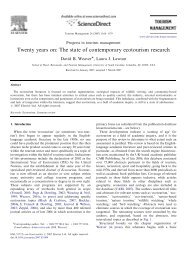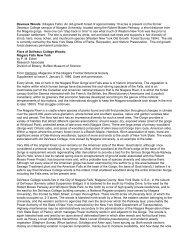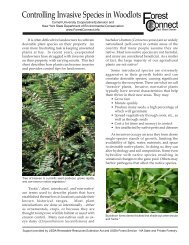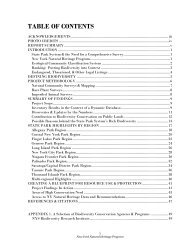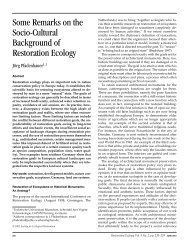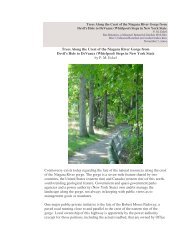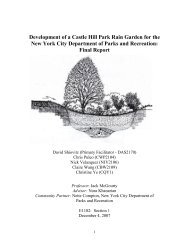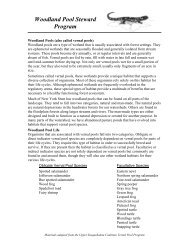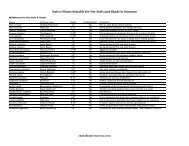active, approximately $575 million per year could be saved over the next four years(Chenoweth, 2003).The costs <strong>of</strong> mental health are also staggering, but could be reduced by regular physicalactivity. In the U.S., mental health disorders are a major public health burden <strong>and</strong> are <strong>of</strong>tenthe cause <strong>of</strong> hospitalization <strong>and</strong> disability. Such disorders cost approximately $148 billionper year (USDHHS, 1996).3.6.3 Benefits <strong>of</strong> Activity: Physical <strong>and</strong> Mental Well-BeingPhysical activity is widely known to reduce the many costly health problems mentionedabove as well as others. This includes obesity, cardiovascular disease (heart disease, stroke,hypertension, congestive heart failure), colon cancer, high blood pressure <strong>and</strong> diabetes.Furthermore, regular physical activity contributes to healthy bones, muscles <strong>and</strong> joints, thusreducing the number <strong>of</strong> falls by older adults <strong>and</strong> relieving arthritis pain. As a result, thereare fewer hospitalizations, physician visits <strong>and</strong> medications needed for active people. Inorder to be beneficial, physical activity does not need to be strenuous. Moderate-intensityphysical activity on a regular basis, such as 30 minutes <strong>of</strong> brisk walking five or more timesa week, is valuable to people <strong>of</strong> all ages (CDCa).People already recognize the benefits <strong>of</strong> outdoor recreation. Three-quarters <strong>of</strong>Americans see it as having a role in helping to reduce childhood obesity, <strong>and</strong>93% <strong>of</strong> Americans believe that if people participated more in outdoor physicalactivities, the health effects would be beneficial. In fact, 90% <strong>of</strong> Americansthink outdoor recreation is seen as the best way to be physically active (OutdoorRecreation in America, 2000).A 2004 survey <strong>of</strong> municipal Chief Administrative Officers showed that 67% <strong>of</strong>them believe that opportunities for physical activity, such as walking to work orplaying in parks, are an important issue to residents in the community <strong>and</strong>another 23% believe it is an emerging issue for residents. The vast majority(98%) felt that it was important for local government to encourage <strong>and</strong> provideopportunities for residents to be physically active. Finally, nearly 89% said<strong>Parks</strong> <strong>and</strong> Recreation Departments should play a leading role in developing acommunity conducive to active living (ICMA, 2004).Outdoor physical activity as alternative transportation, which displacesautomobile use, has the effect <strong>of</strong> improving air quality through reduced pollutionfrom vehicle exhaust. This in turn can result in better health <strong>and</strong> reduced healthcare costs for the entire community. For example, during the 1996 AtlantaOlympic Games, when driving was reduced <strong>and</strong> ambient ozone levels fell by27.9%, emergency room visits for asthma dropped by 41.6% (EPA, 2003).Physical activity is also known to have a positive impact on mental well being. For adultswho have affective disorders, physical activity is known to be beneficial for symptoms <strong>of</strong>depression <strong>and</strong> anxiety. Evidence indicates that physical exercise may stimulate the growth<strong>of</strong> new brain cells that enhance memory <strong>and</strong> learning—two functions hindered bydepression. Studies have also demonstrated that exercise is a viable treatment for97
depression in older adults (Williams, 1996).Between 80%-90% <strong>of</strong> participants in outdoor activities reported that they feelthe natural setting allows them to escape the stress <strong>of</strong> daily life, gives them afeeling <strong>of</strong> accomplishment <strong>and</strong> keeps them feeling young (Exploring the ActiveLifestyle, 2004).Another study found that users <strong>of</strong> greenway trails experience changes inemotion while using recreational trails <strong>and</strong> that as they move through thephysical <strong>and</strong> social surroundings their emotions generally became more positive(Lee, 1999).Walking is known to stimulate the release <strong>of</strong> endorphins, calming brainchemicals that act as natural tranquilizers. Walking also releases adrenaline,which is produced by the body when it senses danger. When adrenalineaccumulates in the body rather than being released, it causes muscle tension <strong>and</strong>can lead to anxiety (Bricklin, 1992).Thus, physical activity has positive effects on mental fitness <strong>and</strong> it can reduce thesymptoms <strong>of</strong> anxiety <strong>and</strong> depression. This may be due, in part, to the fact that using parks<strong>and</strong> trails <strong>of</strong>ten gives people a chance to relax <strong>and</strong> spend quality time with family <strong>and</strong>friends.Wilderness therapy is evolving as an alternative to conventional mental health services <strong>and</strong>mental health providers, insurance companies, <strong>and</strong> juvenile authorities are recognizing itseffectiveness <strong>and</strong> lower cost compared to traditional treatment. The wildernessenvironment, with its solitude <strong>and</strong> natural setting, can be a therapeutic environment foradolescents trying to overcome emotional, addiction, <strong>and</strong> psychological problems <strong>and</strong>benefits participants both physically <strong>and</strong> emotionally. An estimated 10,000 youth participating in wilderness treatment 6 generated $60million in annual revenue in 1998.The costs <strong>of</strong> wilderness therapy averagedabout $325 per day in the five programs, <strong>and</strong> roughly 40 % <strong>of</strong> clients receivedfinancial assistance from medical insurance. Another study extrapolated the datato all known wilderness treatment programs, resulting in annual gross revenues<strong>of</strong> $143 million dollars in 1998 (Russell, 1999). Listed below are some <strong>of</strong> the benefits <strong>of</strong> regular physical activity.o Helps people achieve <strong>and</strong> maintain a healthy body weighto Boosts energy levelo Reduces the risk <strong>of</strong> heart disease by improving blood circulationthroughout the bodyo Helps manage stress <strong>and</strong> promotes psychological well-beingo Reduces the risk <strong>of</strong> strokeo Releases tensiono Reduces the risk <strong>of</strong> having a second heart attack in people who have6 Includes only adolescence wilderness treatment, meaning programs that have specific treatment purposes<strong>and</strong> active field participation or at least clinical supervision by pr<strong>of</strong>essional therapist; does not include youthadventure camps or personal growth programs.98
- Page 1:
ECONOMIC IMPACTS OF PARKS, RIVERS,
- Page 4 and 5:
AcknowledgementsI am grateful to ma
- Page 6 and 7:
3.5.5 Sources of Information.......
- Page 8 and 9:
Table 28. Hiking/Walking Organizati
- Page 10 and 11:
1 IntroductionParks, rivers, trails
- Page 12 and 13:
Table 1.SectionAgency ExpendituresC
- Page 14 and 15:
provide communities with economic,
- Page 16 and 17:
the most current information on the
- Page 18 and 19:
3.1 Agency ExpendituresThis section
- Page 20 and 21:
grants. About 25% of capital expend
- Page 22 and 23:
The Marin Conservation Corps (MCC)
- Page 24 and 25:
already been implemented and is ope
- Page 26 and 27:
Table 5.Net Benefit Per Participant
- Page 28 and 29:
WEST VIRGINIAWISCONSINEarthCorpsFed
- Page 30 and 31:
contracts that gross over $800 mill
- Page 32 and 33:
3.2.2 Special EventsRevenue enhanci
- Page 34 and 35:
park experience to an audience who
- Page 36 and 37:
you have the opportunity to determi
- Page 38 and 39:
Use good survey methods. The better
- Page 40 and 41:
California. A Report to The Sierra
- Page 42 and 43:
powered activities 3 , a participan
- Page 44 and 45:
Table 11. 2003 Sport Footwear Purch
- Page 46 and 47:
3.3.4 Fish and Wildlife-Related Rec
- Page 48 and 49:
EQUIPMENT AND OTHER EXPENSESTotal $
- Page 50 and 51:
Table 17. Estimates of Retail Expen
- Page 52 and 53:
Table 19. U.S. Ski & Snowboard Indu
- Page 54 and 55:
and from services related to the Pa
- Page 56 and 57: o $60 million in Harris County, TX,
- Page 58 and 59: League ofAmericanBicyclistsNational
- Page 60 and 61: SportingGoodsManufacturersAssociati
- Page 62 and 63: necessarily better, especially in s
- Page 64 and 65: Perspective. Available at http://ww
- Page 66 and 67: o Washington: $209 milliono West Vi
- Page 68 and 69: Economic Output Retail Sales Salari
- Page 70 and 71: Economic Output Retail Sales Salari
- Page 72 and 73: Table 35. Economic Impact of Sportf
- Page 74 and 75: All Anglers Non-Resident/Tourist An
- Page 76 and 77: Table 37. Per Capita Travel Receipt
- Page 78 and 79: their decision to return in the fut
- Page 80 and 81: Table 39. Visitors and Spending in
- Page 82 and 83: 2003). Data from California Departm
- Page 84 and 85: over 2003, despite high gas prices,
- Page 86 and 87: management changes or actions are e
- Page 88 and 89: accommodations used, and other trip
- Page 90 and 91: http://www.ncdot.org/transit/bicycl
- Page 92 and 93: 3.5 Estimating the Effects of Spend
- Page 94 and 95: “leakage” of money from the reg
- Page 96 and 97: Keep in mind that multipliers are s
- Page 98 and 99: 3.5.4 How to Use These Rationales i
- Page 100 and 101: economy, only those expenditures th
- Page 102 and 103: For example, be aware of the differ
- Page 104 and 105: 3.6 Health Care and FitnessThis sec
- Page 108 and 109: already had one heart attacko Impro
- Page 110 and 111: uilt as part of sound policy to pro
- Page 112 and 113: accounting for 14 million disabilit
- Page 114 and 115: park amenities available or do not
- Page 116 and 117: National Coalitionfor PromotingPhys
- Page 118 and 119: 100% of all health benefits to a si
- Page 120 and 121: Pratt M, Macera CA, Wang G. 2000. H
- Page 122 and 123: costs than normal weight; moderate
- Page 124 and 125: References for Additional Informati
- Page 126 and 127: 3.7 Benefit EstimationParks, rivers
- Page 128 and 129: Table 47.Forecasted Average Benefit
- Page 130 and 131: Table 48.CriteriaRecreationExperien
- Page 132 and 133: people using carefully designed and
- Page 134 and 135: special government funds for causes
- Page 136 and 137: Loomis, J. B., and White, D.S. 1996
- Page 138 and 139: Economic Assessment for the Necedah
- Page 140 and 141: Commercial UsesExpenditures byResid
- Page 142 and 143: Outcomes Expenditures by GGNRA mana
- Page 144 and 145: local transportation admissions and
- Page 146 and 147: 3.8.8 Educational ValueWhile it may
- Page 148 and 149: the same municipality that are furt
- Page 150 and 151: that do require storm water managem
- Page 152 and 153: Summary of ActionsSimilar to corpor
- Page 154 and 155: 3.9 Resource Book AppendicesSeveral
- Page 156 and 157:
6. Spending in the area. Please rep
- Page 158 and 159:
local economy aren’t bringing in
- Page 160 and 161:
4 ConclusionIn 1995, the National P



